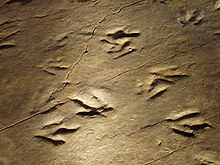Dinosaur State Park and Arboretum

Dinosaur State Park and Arboretum is a 63-acre (25 ha) state park located in Rocky Hill, Connecticut, several miles south of the state capital of Hartford, that preserves one of the largest dinosaur track sites in North America. Its early Jurassic fossil tracks in sandstone date from about 200 million years ago.[1]
History
Extensive fossil discoveries have been made since the 1800s in the Connecticut Valley, with specimens uncovered in the area's brownstone quarries found in museums throughout the world.[1] In 1966, hundreds of dinosaur tracks were exposed in Rocky Hill by a bulldozer operator who was excavating for a new state building.[2] The site was preserved as Dinosaur State Park, and its 7-acre (2.8 ha) dinosaur trackway became a Registered National Landmark in 1968.[3]
Dinosaur tracks
Dinosaur State Park is one of the largest dinosaur track sites in North America. The tracks are from the early Jurassic period and were made over 200 million years ago by a carnivorous dinosaur similar to Dilophosaurus. At present, 500 tracks are enclosed within a 55,000-square-foot (5,100 m2) geodesic dome; the remaining 1,500 are buried for preservation. The park's in-site tracks are Eubrontes, named by Edward Hitchcock, pioneering student of fossilized tracks and one of America's first geologists. The tracks range from 10 to 16 inches (410 mm) in length and are spaced 3.5 to 4.5 feet (1.4 m) apart. The exhibit center also includes rock slabs with other Connecticut Valley fossil tracks, including large four-toed Otozoum tracks with clearly visible skin impressions.[2]
In addition to the tracks, the dome houses life-sized dioramas depicting the Triassic and Jurassic periods, complete with common plants and creatures, and including the aforementioned Dilophosaurus. There are also several interactive displays, a reconstruction of a geologic foundation, and highlights of the tracks’ discovery as well as a discovery room with lizards, Madagascar hissing cockroaches and dinosaur arts and crafts.
Arboretum
The arboretum's goal is to grow representatives of as many Mesozoic Era plant families as possible on the site. The arboretum has more than two miles (3 km) of nature trails with more than 250 species and cultivars of conifers, plus collections of arborvitae, chamaecyparis, ginkgo, juniper, katsura, pine, sequoia, and magnolia. Some rarer species in the arboretum's collection include the evergreen southern magnolia and monkey puzzle. Recent plantings have focused on woody plants from the Cretaceous angiosperm families.[4]
Events and activities
During Dinosaur State Park Day, usually held each year in August, almost 2,000 visitors come to the state park to participate in games, experiment with arts and crafts, and listen to live music, while also visiting the indoor and outdoor features of the park. [5]
The arboretum's auditorium shows educational films on weekends on a rotating schedule. Other activities include educational programs centered around guided trail walks and lectures. During warmer months, visitors can create their own track casts in the track casting area.[6]
See also
- Connecticut River Valley trackways
- List of botanical gardens in the United States
- List of fossil sites (with link directory)
References
- ^ a b "Dinosaur State Park". Connecticut Department of Energy and Environmental Protection. Retrieved February 18, 2013.
- ^ a b "The Trackway at Dinosaur State Park". Friends of Dinosaur Park and Arboretum. Retrieved July 18, 2013.
- ^ "Dinosaur Trackway". National Natural Landmarks. National Park Service. Retrieved July 18, 2015.
- ^ "The Arboretum of Evolution". Friends of Dinosaur Park and Arboretum. Retrieved February 18, 2013.
- ^ "Dinosaur State Park Day". Friends of Dinosaur Park and Arboretum. Retrieved February 18, 2013.
- ^ "Footprint Casting at Dinosaur State Park". Connecticut Department of Energy and Environmental Protection. Retrieved July 18, 2015.
External links
- Dinosaur State Park Connecticut Department of Energy and Environmental Protection
- Dinosaur State Park Friends of Dinosaur Park and Arboretum
- Arboreta in Connecticut
- Botanical gardens in Connecticut
- State parks of Connecticut
- Dinosaur trace fossils
- Fossil trackways in the United States
- Jurassic paleontological sites of North America
- Natural history of Connecticut
- National Natural Landmarks in Connecticut
- Natural history museums in Connecticut
- Dinosaur museums in the United States
- Museums in Hartford County, Connecticut
- Parks in Hartford County, Connecticut
- Rocky Hill, Connecticut
- Protected areas established in 1968
- Fossil parks in the United States
- Paleontology in Connecticut
- 1966 in paleontology
- 1968 in paleontology
